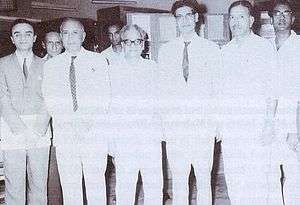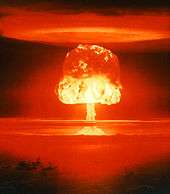Muhammad Raziuddin Siddiqui
| Raziuddin Siddiqui رضی الدین صدیقی | |
|---|---|
|
Raziuddin Siddiqui (second right). | |
| Born |
Muhammad Raziuddin Siddiqui 8 January 1908 Hyderabad, Hyderabad State, British Raj (present-day India) |
| Died |
8 January 1998 (aged 90) Islamabad, Islamabad Capital Territory, Pakistan |
| Citizenship | Pakistani[1] |
| Nationality | Pakistani |
| Fields | Theoretical Physics |
| Institutions |
Pakistan Atomic Energy Commission United Kingdom Atomic Energy Authority Commission for Atomic Energy Quaid-e-Azam University University of Sindh University of Peshawar Osmania University University of Paris Pakistan Mathematical Society |
| Alma mater |
Osmania University, India University of Cambridge, UK University of Leipzig, Germany |
| Doctoral advisor | Werner Heisenberg |
| Known for |
his work on Nuclear energy, theory Relativity and Simultaneity, C*-algebra, Nuclear space (in mathematics), and Paramagnetism Integrated nuclear deterrence development |
| Notable awards |
Sitara-i-Imtiaz (1960) Hilal-i-Imtiaz (1981) Nishan-e-Imtiaz (1998) |
Muhammad Raziuddin Siddiqui, FPAS, NI, HI, SI, PhD (Urdu:محمد رضی الدین صدیقی, [rəzɪ.ʊd̪d̪iːn sɪˈd̪d̪iːqi]; 8 January 1908 – 8 January 1998), also known as Dr. Razi, was a Pakistani theoretical physicist and a mathematician who played a role in Pakistan's education system and Pakistan's integrated nuclear deterrent development.[2] An educationist and a scientist, Siddiqui had established educational research institutes and universities in his country.
During the 1940s in Europe, he contributed in mathematical physics and worked on the theory of relativity, nuclear energy, and the Quantum gravity.[2]
He had been the Vice-Chancellor of four Pakistan universities and the first V.Chancellor of Quaid-e-Azam University and served as the Emeritus professor of Physics there until his death in 1998.[2]
Biography
Life and education
Raziuddin Siddiqui was born on 8 January 1908 in Hyderabad- Deccan, India. He was one of the students who attended the newly established Osmania University. After passing the Rashidia Exams in 1918, Siddiqui completed his matriculation from Osmania University in 1921, and earned the BA degree in Mathematics with distinction in 1925.[3] He was one of the graduates of the first batch of Osmania University, in 1925.[3]
Siddiqui in Europe
He was then awarded a scholarship from the Government of State of Hyderabad to pursue higher studies in United Kingdom where he completed his MA in Mathematics, under Paul Dirac from the University of Cambridge in 1928.[2][3] Then, he proceeded further to work for his PhD at the University of Leipzig in Germany (Weimar Republic).[3]
He studied Mathematics and Quantum mechanics under Albert Einstein in Berlin and Heisenberg at Leipzig.[4] He completed his PhD in Theoretical Physics, writing a brief research thesis on the Theory of relativity and the Nuclear energy.[4] He did his post doctoral work at the University of Paris, France.[4]
Research in theoretical physics
In Europe, while Siddique was working on his post-doctoral research at the Paris University, he had the opportunity to meet with the members of "The Paris Group"[5] where he had led the discussions on unsolved problems in physics and in mathematics.[6] During his stay in Great Britain, he studied Quantum mechanics and published scientific papers at the Cavendish Laboratory.[7]
Return to India
In 1931, Raziuddin Siddiqui then returned to Hyderabad, British Indian Empire, and joined Osmania University, Hyderabad, as an Associate Professor of Mathematics.[7] During 1948–49, he served as Vice-Chancellor of Osmania University, appointed by the Governor.
Move to Pakistan
After the independence of Pakistan in 1947, at the request of the Government of Pakistan, Dr. Siddiqui migrated to Karachi, Pakistan in 1950, along with the majority of his family. In Karachi, he joined the Karachi University's teaching faculty and taught as Professor of Applied Mathematics there.[7] In 1953, he was simultaneously appointed to the post of Vice-Chancellor of the University of Sindh and the University of Peshawar. Dr. Siddiqui founded the first mathematical society in Pakistan in 1952 by the name of "All Pakistan Mathematics Association" (now known as Pakistan Mathematical Society), and remained its President until 1972.[7] In 1956, Siddiqui helped establish the nuclear power and its expansion in the country by first joining the newly established Pakistan Atomic Energy Commission (PAEC) and then establishing the first science directorate on Mathematical physics.[8]
In 1964, he moved to Islamabad where he joined Pakistan Atomic Energy Commission. There he began his academic research in theoretical physics.[7] In 1965, with the establishment of Quaid-e-Azam University (Qau), Dr. Siddiqui was appointed as its first Vice-Chancellor by the then Foreign Minister Zulfikar Ali Bhutto.[9] He was one of the first professors of Physics at the Quaid-e-Azam University where he also served as the Chairman of the Physics Department.[9] He continued his tenure until 1972, when he rejoined the PAEC at the request of Prime Minister Bhutto.[9] During the 1960s, he helped convince President Field Marshal Ayub Khan to make a proposed university a research institution.[9] He, at first, established "Institute of Physics" at the Qau, and invited Professor Riazuddin to be its first director and the Dean of the Faculty. Then, Professor Riazuddin, with the help of his mentor Dr. Abdus Salam, convinced the then PAEC chairman Dr. Ishrat Hussain Usmani to send all the theoreticians to Institute of Physics to form a physics group.[9] This established the "Theoretical Physics Group", which later designed the nuclear weapons for the country.[9]
With the establishment of TPG, Raziuddin Siddiqui began to work with Dr. Abdus Salam, and on his advice began the research in Theoretical Physics at the PAEC.[9] In 1970, he established the Mathematical Physics Group at the PAEC, where he led academic research in advanced mathematics.[9] He also delegated mathematicians to PAEC to specialise in their fields at the MPG Division of PAEC.[9]
The atomic bomb project
After the Indo-Pakistani War of 1971, Siddiqui joined the Pakistan Atomic Energy Commission (PAEC) at the request of Prime minister Zulfikar Ali Bhutto. Siddiqui was the first full-time Technical Member of the Pakistan Atomic Energy Commission and was responsible for the preparation of its charter.[10]
During the 1970s, Siddiqui worked on problems in theoretical physics with Pakistani theoretical physicists in the integrated atomic bomb project.[11] Previously, he had worked in Europe, including carrying out nuclear research in the British nuclear program, and the French atomic program.[11] At the PAEC, he became a mentor of some of the country's academic scientists.[11] At PAEC, he was the director of the Mathematical Physics Group (MPG) and was tasked with performing mathematical calculations involved in fission and supercomputing. While both MPG and Theoretical Physics Group (TPG) had reported directly to Abdus Salam, Siddiqui co-ordinated each meeting with the scientists of TPG and mathematicians of the MPG.[11] At the PAEC, he directed the mathematical research directly involving the general relativity, and helped establish the quantum computers laboratories at the PAEC.[11]
Since theoretical physics plays a major role in identifying the parameters of nuclear physics, Siddiqui started the work on special relativity's complex applications, the "Relativity of simultaneity".[11] His Mathematical Physics Group undertook the research and performed calculations on "Relativity of simultaneity" during the process of weapon detonation, where multiple explosive energy rays are bound to release in the same isolate and close medium at the same time interval.[11]
Post-war
After his work at the PAEC, Raziuddin Siddiqui again joined Quaid-e-Azam University's Physics Faculty.[7] As professor of Physics, he continued his research at the Institute of Physics, Qau.[7] He helped develop the higher education sector, and placed mainframe policies in the institution.[7]
Death and legacy
Siddiqui remained in Islamabad, and had associated himself with Quaid-e-Azam University. In 1990, he was made Professor Emeritus of Physics and Mathematics there.[7] He died on 8 January 1998, at the age of 90. Siddiqui's biography was written by scientists who had worked with him. In 1960, due to his efforts to expand education, he was awarded the third-highest civilian award of Pakistan, Sitara-i-Imtiaz, from the then-President of Pakistan, Field Marshal Ayub Khan.[7]
In 1981, he was awarded the second highest civilian award, Hilal-i-Imtiaz, from President General Muhammad Zia-ul-Haq due to his efforts in Pakistan's atomic program, and popularising science in Pakistan. In May 1998, the Government of Pakistan awarded him the highest civilian award, Nishan-i-Imtiaz posthumously by the prime minister Nawaz Sharif when Pakistan conducted its first successful nuclear tests.[7]
Family
His eldest daughter, Dr. Shirin Tahir-Kheli, is a former Special Assistant to the President of the United States of America, and Senior Adviser for women's empowerment.[12]
Civil awards
- Sitara-i-Imtiaz (1960)
- Hilal-i-Imtiaz (1981)
- Nishan-e-Imtiaz (1998)
- Gold Medal, Pakistan Academy of Sciences (1950)
- Gold Medal, Pakistan Mathematical Society (1980)
- Gold Medallion, Pakistan Physical Society (1953)
- Doctorate of Science Honoris Causa, Osmania University (1938)
Books
- Quantum Mechanics and its Physics
- Dastan-e-Riazi (The Tale of Mathematics)
- Izafiat
- Tasawur-e-Zaman-o-Makaan
- Experiences in science and education by M. Raziuddin Siddiqui, published in 1977.
- Establishing a new university in a developing country: Policies and procedures by M. Raziuddin Siddiqui, published in 1990.
See also
References
- ↑ -Dr Abdus Salam – The ’Mystic’ scientist
- 1 2 3 4 Khan, PhD, Aqeel (7 June 2001). "Development of Nuclear Industry in Pakistan". Professor Aqeel Khan, professor of Political Science at the Ryerson University. Dr. Aqeel Khan of the Ryerson University and the Ryerson University Press. Retrieved 15 August 2011.
- 1 2 3 4 "The education setback of 1948". Syed Muslehuddin Ahmed and Dawn News. Dawn Group of Newspapers. 19 December 2010. Retrieved 2011.
|first1=missing|last1=in Authors list (help); Check date values in:|access-date=(help) - 1 2 3 Siddiqui, Saifuddin. "Mohammad Raziuddin Siddiqui". Saifuddin Siddiqui.
- ↑ Rehman, Shahidur, Long Road to Chagai, A Cue From Manhattan Project, pp16
- ↑ Siddiqui, Professor Razi, Pakistani Theoretical Physicists, an early research in physics, pp49.
- 1 2 3 4 5 6 7 8 9 10 11 Salman Hameed, Dr. Salman (19 October 1998). "A Science Oddyssey: Pakistan's nuclear emergence". Dr. Salman Hameed, Member of the Theoretical Physics Group at PAEC. Dr. Salman Hameed, Professor of Theoretical Physics at the University of Massachusetts Amherst and Smith College, USA. The Conference held at the Alhamra Cultural Complex, Qaddafi Stadium, Lahore. Check date values in:
|access-date=(help); - ↑ Bhatnagar, Arun (20 November 2011). "A leaf from history: Pioneers in science". The Dawn Newspapers (20 November 2011). Retrieved 24 January 2012.
- 1 2 3 4 5 6 7 8 9 Hussain, Faheem (June 2005). "The Theoretical Physics Group at Quaid-e-Azam University." (PDF). Faheem Hussain, eminent scientists in the field of Physics. Faheem Hussain, professor of physics at Lahore University of Management Sciences (LUMS). Retrieved 2011. Check date values in:
|access-date=(help) - ↑ Sheikh, F.D. "The Galaxy of Pakistani scientists:Dr. Raziuddin Siddiqui". Eminent scientists in the field of Physics. F.D. Sheikh. Retrieved 2010. Check date values in:
|access-date=(help) - 1 2 3 4 5 6 7 Shahid-Ur-, Rehman (1999). "Ibid". Long Road To Chagai. Islamabad, Pakistan: Print Wise Publication. p. 10. Check date values in:
|access-date=(help); - ↑ Shirin Tahir-Kheli – Senior Advisor to the Secretary of State
Bibliography
- Rahman, Shahidur (1999) [1999], "Theoretical Physics Group: A Cue from Manhattan Project?; §A Manhattan Project Scientist;§PAEC versus KRL: Wheels within Wheel;§Pakistan nuclear technology project: from Pakistan's Theoretical Physics to the making of the bomb", Long Road to Chagai, Islamabad, Islamabad Capital Territory (Pakistan): Printwise Publications, ISBN 969-8500-00-6
External links
- Muhammad Raziuddin Siddiqui
- Dr. Raziuddin Siddiqui Memorial Library
- Ias.ac.in
- Iiit.ac.in, Iqbal Ka Tasawwuf-e-Zaman-o-MakaN at Digital Library of India

